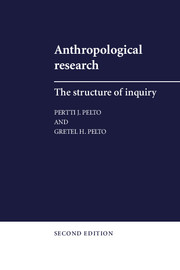Book contents
- Frontmatter
- Contents
- Preface to second edition
- Preface to first edition
- 1 The domain of methodology
- 2 Science and anthropology
- 3 Operationalism in anthropological research
- 4 Units of observation: emic and etic approaches
- 5 Tools of research – I
- 6 Tools of research – II: nonverbal techniques
- 7 Counting and sampling
- 8 Measurement, scales, and statistics
- 9 Art and science in field work
- 10 Research methods, relevance, and applied anthropology
- 11 Building anthropological theory: methods and models
- Appendixes
- A Notes on research design
- B The Guttman Scale: a special type of ordinal measure
- C On using computers
- Bibliography
- Index
A - Notes on research design
Published online by Cambridge University Press: 05 June 2012
- Frontmatter
- Contents
- Preface to second edition
- Preface to first edition
- 1 The domain of methodology
- 2 Science and anthropology
- 3 Operationalism in anthropological research
- 4 Units of observation: emic and etic approaches
- 5 Tools of research – I
- 6 Tools of research – II: nonverbal techniques
- 7 Counting and sampling
- 8 Measurement, scales, and statistics
- 9 Art and science in field work
- 10 Research methods, relevance, and applied anthropology
- 11 Building anthropological theory: methods and models
- Appendixes
- A Notes on research design
- B The Guttman Scale: a special type of ordinal measure
- C On using computers
- Bibliography
- Index
Summary
Research design involves combining the essential elements of investigation into an effective problem-solving sequence. Thus the plan of research is a statement that concentrates on the components that must be present in order for the objectives of the study to be realized. The trimmings, the tangential matters – all the behind-the-scenes details of “what really happens in research” – are left out in order to present an idealized master plan.
Effective structuring of research designs is essential to productive scientific work, although the ablest scientists are those who are also masters of the unspecifiable interstitial skills that make up the art of scientific investigation. Creative development of new research ideas cannot be planned; effective exploitation of research serendipity often follows no preestablished sequences; and many other important aspects of the research enterprise are not included in our formal statements of research plans. Nonetheless, it is useful to review some main elements of structure that enhance the researcher's chances of achieving his knowledge-building objectives.
Formulation of a research problem
In anthropology we find a wide variety of research intentions, ranging from precisely defined testing of hypotheses (e.g., concerning covariations of a few cultural elements) to general explorations of one or another cultural domain, such as kinship or religious beliefs.
- Type
- Chapter
- Information
- Anthropological ResearchThe Structure of Inquiry, pp. 291 - 297Publisher: Cambridge University PressPrint publication year: 1978

